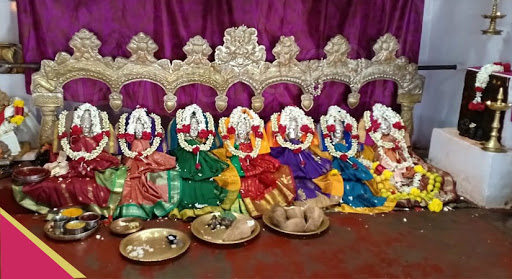|
The Sapta
Matrikas or the seven divine mothers, representing the
saktis, or the energies of the important familiar deities
are Brahmani (Saraswati) Mahesvari (Raudani) Kaumari (Karttikeyani)
Vaishnavi (Lakshmi) Varahi, Indrani and Chamunda (Chamundi).
According to a legend described in the
Isanasivagurudevapaddhati, the Matrikas were created to help
Lord Siva in his fight against Andhakasura. When Lord Shiva
inflicted wounds on Andhaka, blood began to flow profusely
from his body. Each drop which touched the ground assumed
the shape of another Andhaka. Thus there were innumerable
Asuras fighting Siva. To stop the flow of the blood, Siva
created a goddess called Yogesvari from the flames issuing
out of his mouth. Brahma, Vishnu, Maheswara, Kumara, Varaha,
Indra and Yama also sent their saktis to follow Yogesvari in
stopping the flow of blood. Thus the Sapta Matrikas
originated and Andhakasura finally lost his power and was
defeated by Siva.
In the Suprabhedagama, the Matrikas are said to have been
created by Brahma in order to kill Nirrita. The Agama
literature gives a brief description of these goddesses :
that Brahmani should be sculptured like Brahma; Mahesvari
like Mahesvara; Vaishnavi like Vishnu; Varahi as a short
woman with an angry face and bearing a plough as her weapon;
Indrani like Indra and Chamunda as a terrific woman. This
lastmentioned goddess should have her hair in a dishevelled
condition, should possess a dark complexion and have four
hands. She should weild the trisula in one of her hands and
carry a kapala in another. All the Matrikas are to be seated
images and should have two of their hands held in the Varada
and Abhaya poses, while the other two hands carry weapons
appropriate to the male counterparts of the female powers.
The Varaha Purana states that these mother-goddesses are
eight in number and includes among them the goddess
Yogesvari. It further says that these Matrikas represent
eight mental qualities which are morally bad. Accordingly,
Yogesvari represents kama or desire; Mahesvari, krodh or
anger; Vaishnavi, lobha or covetousness; Brahmani, mada or
pride; Kaumari moha or illusion; Indrani, matsarya or fault
finding; Yami or Chumunda paisunya, that is tale bearing;
and Varahi asuya or envy.
The Sapta Matrikas are mentioned in the Rigveda,
Gobhilasmriti, Markandeya Purana, Matsya Purana, etc.
Varahamihira’s Brihat Samhita also mentions about the
images of Sapta Matrikas. The sculptures of the Sapta
Matrikas are referred to in the Krityaratnakara. The Devi
Purana mentions the name of the flowers used for the worship
of Matrikas. Prevalence of the worship of the divine mothers
is believed to be as early as 3rd millennium B.C., when the
Indus Valley Civilization flourished. The earliest
epigraphic reference to the Matrikas is to be found in the
Gangadhara inscription of Vishwa Varman, in Malwa Samvat 480
or 423-424 A.D. The Matrikas also figure in the Viharstambha
inscription of Skandagupta.
Kadambari mentions that the Matrikas were worshipped in
every village. The several Tantra sastras such as Svachhanda
Tantra and Yogini Hridaya contain a detailed description of
the Sapta Matrikas. As the Matrikas are stated to be sitting
in lalitasana posture, they are adorned with heavy
ornaments, necklaces and circular ear-rings. From the
Sadhana in the Buddhist literature it appears that the
Tantric Buddhism had also incorporated the Sapta Matrikas in
its religious fold. This is amply corroborated by the
discovery of a composite figure of the seven mothers at
Nalanda. |
